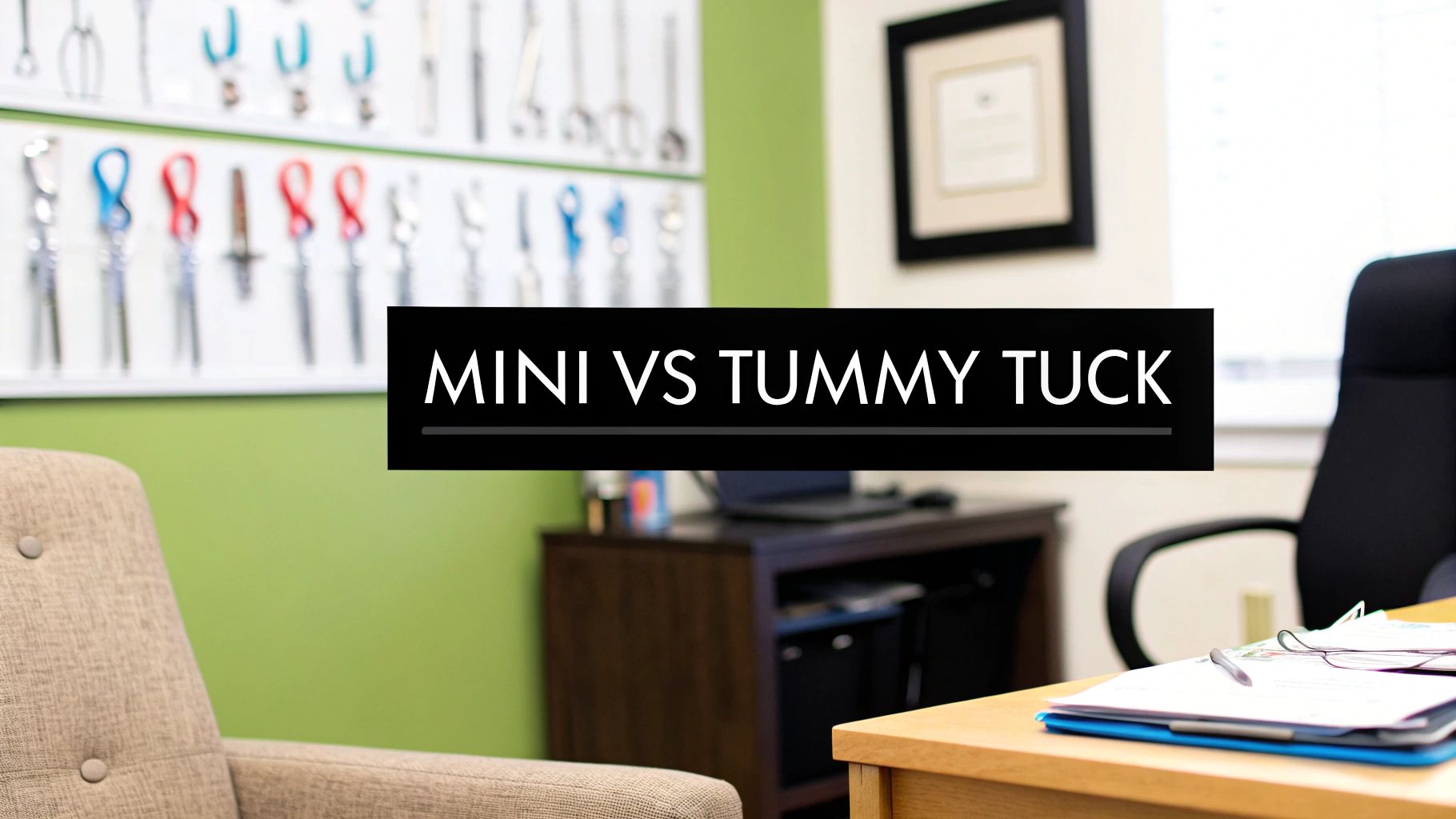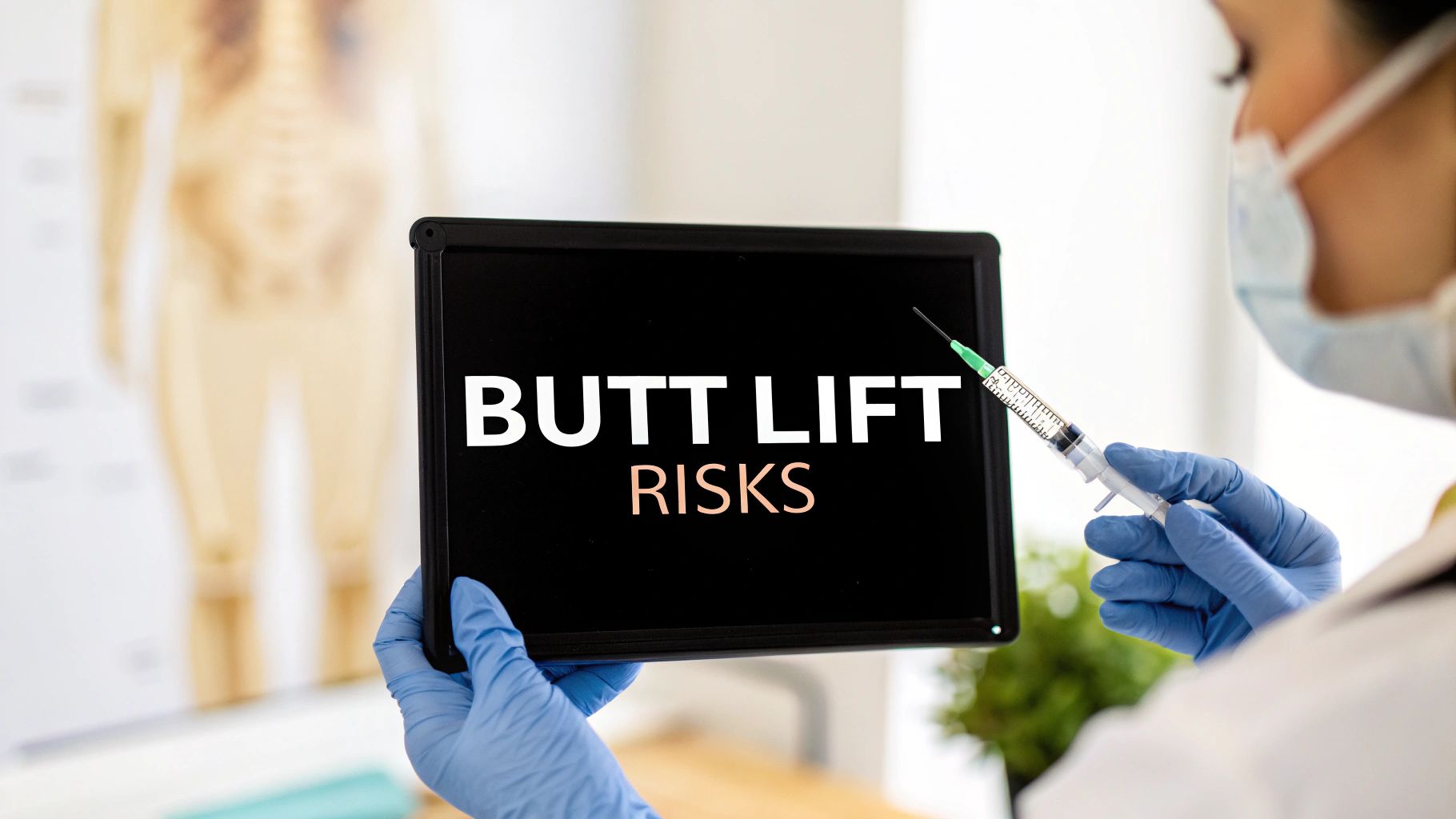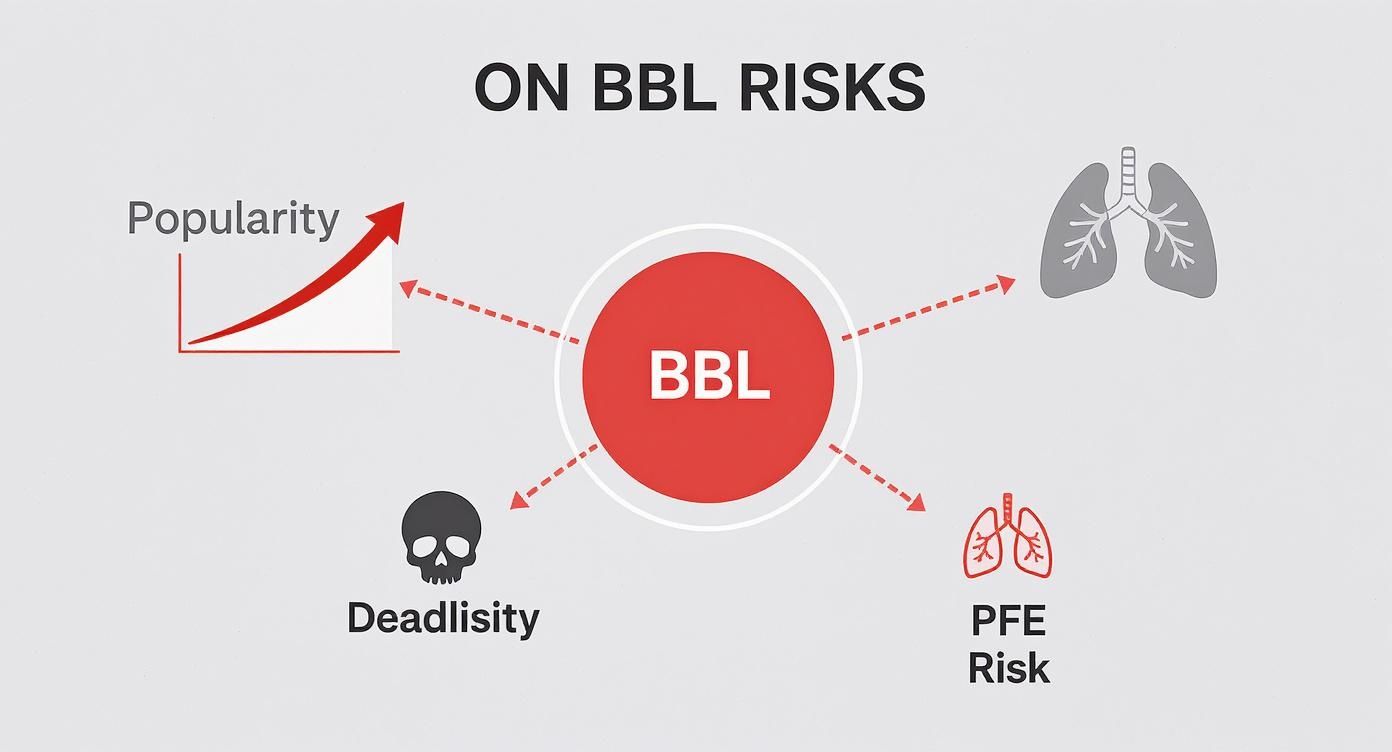
December 13, 2025
Mini Tummy Tuck vs. tummy tuck: Which Is Right for You
Discover the mini tummy tuck vs. tummy tuck differences, candidacy, recovery, scars, and cost to help you decide.
Oct 28, 2025

The Brazilian Butt Lift, or BBL, has become a household name in cosmetic surgery. But behind its popularity lies a serious and often understated fact: it's considered the single most dangerous aesthetic procedure you can have. The biggest danger is a pulmonary fat embolism (PFE), a life-threatening event where fat gets into the bloodstream and travels to the lungs, blocking vital arteries.
The appeal of the BBL is easy to understand. It’s a two-in-one procedure: fat is removed via liposuction from a place you don't want it, like the stomach or thighs, and then transferred to the buttocks to add volume and create a more desirable shape. It promises a natural-looking result using your own tissue, which is a huge draw for many people.
But the social media hype doesn't tell the whole story. The procedure's rise in popularity has been shadowed by some genuinely alarming safety concerns. With such high demand, the market has unfortunately been flooded with unqualified or undertrained providers offering deep discounts, which dramatically increases the risk of a tragic outcome.
The numbers don't lie. The BBL continues to be one of the riskiest cosmetic surgeries available. In 2021, surgeons in the US performed over 60,000 BBLs. That's a 37% jump from 2020 and a staggering 731% increase since 2011.
This explosive growth has come with a high cost. The procedure carries a significant fatality rate, almost always due to a pulmonary fat embolism caused by fat being injected into the wrong place. Really grasping the weight of these statistics is the first step in making a smart, safe choice. It’s why doing your homework and choosing the right surgeon isn't just a good idea—it's essential. For a wider view on surgical risks, our guide on general plastic surgery safety offers some great context.
We're going to move past the simple warnings and dive deep into the specific brazilian butt lift risks. The goal here is to give you knowledge, not to scare you. We'll break down the complicated medical side of things into plain English, explaining exactly what can go wrong and why.
The single most important factor for a safe BBL is the surgeon's technique. A deep knowledge of the gluteal anatomy and an unwavering commitment to injecting fat only into the superficial fat layer (subcutaneous tissue) is what prevents a deadly embolism.
Here’s what we’ll cover:
By the time you're done reading, you'll have a clear framework to weigh the risks and make a decision that puts your health and safety first.
To really grasp the most serious risks of a Brazilian butt lift, we need to look at the anatomy of the buttocks. Picture it as having two distinct layers. Right under the skin is a safe layer of fat called subcutaneous fat. Deeper down, you find the large gluteal muscle. This isn't just a minor detail—it's the line between a successful surgery and a fatal one.
Think of it like planting a garden. When a surgeon injects fat into that top subcutaneous layer, it's like placing a seed in nutrient-rich soil. The fat cells have a great chance to settle in, develop a blood supply, and thrive. But injecting that same fat deep into the muscle? That's like accidentally hitting a major water main buried underground. The result can be immediate and catastrophic.
This visual gives you a quick rundown of the main risk factors to keep in mind with BBLs.

The infographic gets to the heart of the BBL paradox: it's a wildly popular procedure that also happens to be the deadliest cosmetic surgery, almost entirely because of the risk of a pulmonary fat embolism.
The gluteal muscle isn’t just tissue; it's crisscrossed with large, powerful blood vessels. These veins are essentially superhighways that lead directly into your body's central circulatory system, connecting straight to the heart and lungs. If a surgeon accidentally injects fat into this muscle, those fat droplets get swept up into the bloodstream.
Once they're in the bloodstream, these globules of fat travel fast. Their first major stop is the lungs. There, they can get stuck in the small arteries, creating a blockage that stops blood flow. This is a pulmonary fat embolism (PFE), and it is the number one cause of death from BBL surgery.
A pulmonary fat embolism is a purely mechanical problem, like a clog in a drain. The fat physically obstructs blood from moving through the lungs. This causes oxygen levels to plummet, which can lead to cardiac arrest and, tragically, death.
This is exactly why the surgeon's skill and technique are everything. Their ability to expertly navigate the gluteal anatomy and place fat only in that safe, subcutaneous space is the single most critical factor in preventing a fatal outcome.
A key part of preventing this comes down to understanding the definition of tissue perfusion, which is all about how blood flows through the body's tissues. The right technique ensures the newly transferred fat gets the blood supply it needs to survive, all while staying clear of those major blood vessels.
The main driver behind BBL fatalities—fat embolism—almost always happens when fat is mistakenly injected into or even below the gluteal muscle. This is what gives fat a direct entry point into the bloodstream, where it can cause deadly blockages. It’s no surprise that this kind of devastating complication is far more common when the procedure is performed by an unlicensed or inexperienced practitioner.
To steer clear of this danger zone, experienced surgeons adhere to a strict set of rules:
The choice of a surgeon is, without a doubt, the most important safety decision a patient can make. Your own research and diligence in this area will have a direct impact on your risk. To get you started, take a look at our guide on how to choose a surgeon.
When people talk about brazilian butt lift risks, the conversation almost always turns to fat embolism, and for good reason. It’s the most dangerous potential outcome. But focusing only on that one risk is like only looking at the tip of an iceberg—there's a whole spectrum of other complications to understand before you decide if this surgery is right for you.

It’s helpful to break these risks down into two main groups: the more common issues that affect how your final result looks, and the much rarer, but far more serious, medical emergencies that can threaten your health.
Let's be clear: even with a top-tier surgeon, the healing process has a mind of its own. Your body’s unique response to surgery can sometimes lead to results that aren’t quite what you envisioned.
These issues aren't typically life-threatening, but they can be disappointing and might even require a second surgery to fix.
Think of it like trying to transplant a delicate plant. You can have the best soil and the perfect technique, but some of the roots just might not take hold in the new environment. Fat necrosis is the surgical version of that—some cells just don't make it.
It's all about realistic expectations. Most surgeons will tell you that they expect only about 60-80% of the transferred fat to survive long-term. A great surgeon knows this and plans for that expected loss from the very beginning.
Now we get to the other side of the coin—the serious complications. These are the risks that make it absolutely critical to choose a board-certified plastic surgeon operating in an accredited facility. They are rare, but they are real, and they demand immediate medical attention if they occur.
These events are often tied to the physical stress of the surgery or, frankly, to poor surgical technique.
Deep Vein Thrombosis (DVT)
A DVT is a blood clot that forms in a deep vein, usually in your legs. Any major surgery carries this risk because you’re immobile for a long period. The real danger is if a piece of that clot breaks free and travels to the lungs, causing a pulmonary embolism (PE)—a deadly blockage that is different from a fat embolism.
Organ Damage
The liposuction part of the BBL procedure isn't just about suctioning fat; it involves a sharp instrument moving around under your skin. In the hands of someone inexperienced, that cannula can accidentally puncture an internal organ, like your bowel. This is an absolute surgical emergency.
Severe Infections
Any cut in the skin can get infected, but a deep infection after a BBL can be a disaster. It can kill the newly placed fat cells, create painful abscesses, and in the worst-case scenario, lead to sepsis—a body-wide, life-threatening reaction. This is why sterile technique and following post-op care instructions to the letter are so important.
To help put all of this into perspective, the table below breaks down the most common and the most severe complications you should be aware of.
This table categorizes potential BBL complications by their frequency and severity, helping patients understand the full range of risks from aesthetic dissatisfaction to life-threatening emergencies.
Seeing it all laid out makes one thing clear: while the goal of a BBL is a beautiful new shape, your top priority has to be your safety. Understanding the full picture of brazilian butt lift risks is the first and most important step in protecting yourself.
For a while, the Brazilian butt lift was on a meteoric rise, but a shadow of uncertainty followed it. Surgeons had a gut feeling it was riskier than other cosmetic procedures, but the hard data was all over the place. That all changed in 2017, when a single study sent a jolt through the entire plastic surgery community, forcing everyone to confront a difficult reality.
The report was nothing short of a wake-up call. A 2017 survey of surgeons revealed a staggering mortality rate for the BBL: roughly 1 in 3,000 patients. To put that in perspective, this was exponentially higher than any other aesthetic surgery. This single statistic ignited a firestorm of media coverage and sparked urgent, global conversations about whether the procedure was too dangerous to continue.
This wasn't just another number in a medical journal; it was a crisis. The data confirmed the community's worst fears and kicked off a worldwide effort to figure out what was going wrong—and fix it before more lives were lost.
In the face of these frightening numbers, the world’s top plastic surgery organizations didn’t hesitate. They came together to form the Multi-Society Gluteal Fat Grafting Task Force, a team of experts with one clear mission: find out why BBLs were so deadly and create a new, safer way forward.
Think of them as medical detectives. The task force dug deep, meticulously reviewing every documented case of a BBL-related death. They pored over surgical notes and autopsy reports, searching for a common denominator. Soon, a tragically clear pattern emerged, pointing to a single, fatal mistake in technique.
The investigation uncovered a chilling fact: in almost every death, fat was found inside the gluteal muscle. This was the smoking gun. Intramuscular injection was the culprit, turning the muscle's dense network of blood vessels into a direct highway for fat to enter the bloodstream and cause a deadly embolism.
This discovery was the breakthrough everyone was looking for. It proved the BBL wasn't inherently lethal; a specific, and most importantly, preventable, technique was to blame. This kind of response, driven by data and a commitment to patient well-being, is a perfect example of quality improvement in healthcare in action.
With this concrete evidence in hand, the task force moved quickly to establish new safety guidelines that have completely transformed how BBLs are performed today. These weren't just friendly recommendations; they were urgent, evidence-based directives designed to stop the most dangerous of all brazilian butt lift risks in its tracks.
The new gold standard for BBL safety is built on a few non-negotiable pillars:
This whole story—from crisis to resolution—is a powerful testament to how collaborative, data-driven science can turn a dangerous situation around. While no surgery is ever completely without risk, the work done since that 2017 alarm bell has made the BBL a profoundly safer procedure than it was just a decade ago.
Knowing the full scope of brazilian butt lift risks is one thing, but taking direct action to protect yourself is what truly matters. Your safety isn't left to chance—it's the direct outcome of smart choices and diligent research. Think of this checklist as your personal guide to vetting your surgeon and their facility, making sure you place your trust in the most capable hands.

Approach this like you're hiring an expert for a high-stakes project. You wouldn't hire a contractor to build your house without checking their credentials and past work. The same level of scrutiny is absolutely essential when choosing your BBL surgeon.
The single most important decision you'll make is who performs your surgery. Not all doctors are the same, and fancy-sounding titles can be incredibly misleading. This is where you need to be tough.
Your goal is to find a surgeon who is board-certified specifically in plastic surgery. The term "cosmetic surgeon" isn't a recognized specialty board by the American Board of Medical Specialties and can be used by any doctor with only minimal training.
A board-certified plastic surgeon has completed at least six years of surgical training, with a minimum of three years focused exclusively on plastic surgery. They've passed rigorous oral and written exams, proving their expertise meets the highest standards for patient safety.
Use these non-negotiable checks to verify any surgeon you're considering:
Getting these basics right filters out the unqualified practitioners from the start.
Your consultation is really an interview—and you're the one in charge. Don't be shy. A confident and transparent surgeon will welcome your questions and answer them clearly. How they respond tells you everything about their experience, technique, and dedication to safety.
Walk into that meeting with a list of questions ready to go. The answers will help you gauge their expertise and see if their methods align with today's safety standards.
Here are the crucial questions you must ask:
"How many BBL procedures do you perform each month and each year?"
This gives you a real-world picture of their experience. A surgeon who performs the procedure frequently is far more likely to be on top of the latest safety protocols.
"What is your specific technique for fat injection?"
The only answer you want to hear is that they inject only into the subcutaneous fat layer—the space above the muscle. They should state clearly that they never inject into the gluteal muscle. Any hesitation here is a massive red flag.
"Do you use ultrasound guidance during the injection phase?"
This technology has been a game-changer for BBL safety. It lets the surgeon see exactly where the cannula is in real-time, confirming it's in the safe zone and away from the dangerous veins deep in the muscle. While it's not a mandatory tool for every great surgeon, its use shows a strong commitment to the highest safety standards.
"Can I see before-and-after photos of patients with a body type similar to mine?"
This isn't just about results; it's about realistic expectations. Seeing their work on bodies like yours helps you assess their artistic style and whether it matches your goals.
"What is your complication rate for this procedure, and how do you handle complications?"
Every surgeon, no matter how skilled, experiences complications. An honest one will be upfront about their rates and have a clear, established plan for what to do if something goes wrong.
These questions cut right through the marketing fluff and get to what really matters: your safety.
Where your surgery happens is just as critical as who performs it. An operation in a poorly equipped or unaccredited facility exponentially increases your risk of infection and other serious problems.
Your BBL should be performed in a facility accredited by a nationally recognized organization, such as the American Association for Accreditation of Ambulatory Surgery Facilities (AAAASF) or The Joint Commission. This certification is your proof that the facility meets hospital-grade standards for safety, sterility, and emergency readiness.
Before you commit, you need to understand every part of the process. To help with that, exploring a guide on how to prepare for surgery offers excellent insights into pre-op steps that lead to a safer outcome. By following this checklist, you shift from being just a patient to an empowered advocate for your own well-being, actively reducing your exposure to the most serious brazilian butt lift risks.
It's completely normal to have questions when you're considering a BBL. Getting clear, straightforward answers is a crucial part of the process. Let's walk through some of the most common concerns patients have about the risks involved.
Without a doubt, the most serious risk is a pulmonary fat embolism, often called a PFE. This is a life-threatening emergency that happens when fat is mistakenly injected deep into the large gluteal muscle.
From there, the fat can get into major blood vessels and travel to the lungs, creating a deadly blockage. The key to avoiding this devastating complication lies entirely in the surgeon's technique. A skilled, responsible surgeon will only inject fat into the subcutaneous layer—the safe space that sits right above the muscle.
Many of today's top surgeons take safety a step further by using ultrasound guidance. This lets them watch the injection cannula in real-time on a screen, ensuring it never enters that muscular danger zone.
Yes, there are other options out there, but it's important to understand that they deliver very different results. Each has its own set of pros and cons you'll want to weigh against what you're hoping to achieve.
Doing your homework on a surgeon is non-negotiable—it's the most important thing you can do for your own safety. A truly qualified surgeon will appreciate your diligence and welcome your questions.
First, check that they are certified by the American Board of Plastic Surgery (or the equivalent board in your country). Next, find out if they have hospital privileges to perform BBLs. This is a big deal because it means they’ve passed a hospital’s own rigorous screening process.
Don't be shy about asking direct questions. Ask them: How many BBLs do you perform a year? Can you explain your exact injection technique? Do you use ultrasound to guide your injections? An experienced and transparent surgeon will have confident, clear answers for you.
In almost every case, yes. An unusually low price is one of the biggest red flags in this industry. It almost always means corners are being cut somewhere, and that's usually on safety protocols.
The cost of a BBL doesn't just cover the surgeon's time. It includes the anesthesiologist's expertise, the use of a fully accredited surgical facility, and a highly trained support staff. A price that seems too good to be true is likely sacrificing one of these critical elements to get the number down. While your budget is important, it should never be the deciding factor when it comes to a procedure with such high stakes.
At Cape Cod Plastic Surgery, Dr. Fater’s commitment to patient safety is our highest priority. We use the most advanced techniques in our fully accredited surgical facility to ensure the best possible outcomes. To talk about your goals and see how we put safety first, please schedule your consultation today.

December 13, 2025
Discover the mini tummy tuck vs. tummy tuck differences, candidacy, recovery, scars, and cost to help you decide.
December 12, 2025
Deciding between silicone vs saline breast implants? This guide compares feel, safety, rupture risks, and costs to help you make an informed choice.

December 12, 2025
Inspiring Journeys: How Real Patients Achieved Remarkable Transformations